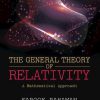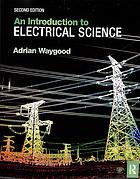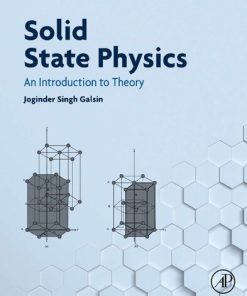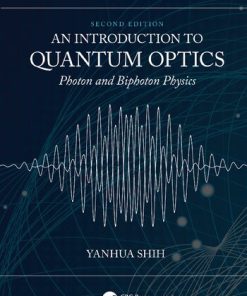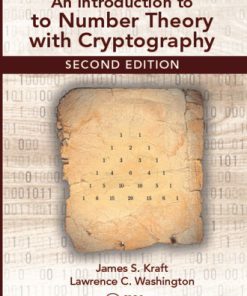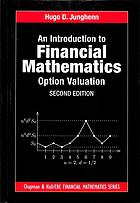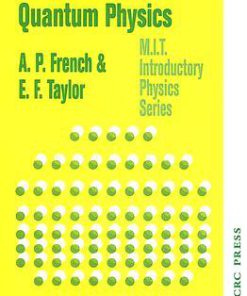An Introduction to Geometrical Physics 2nd Edition by Ruben Aldrovandi 9813146839 9789813146839
$50.00 Original price was: $50.00.$25.00Current price is: $25.00.
An Introduction to Geometrical Physics 2nd Edition by Ruben Aldrovandi – Ebook PDF Instant Download/DeliveryISBN: 9813146839, 9789813146839
Full download An Introduction to Geometrical Physics 2nd Edition after payment.
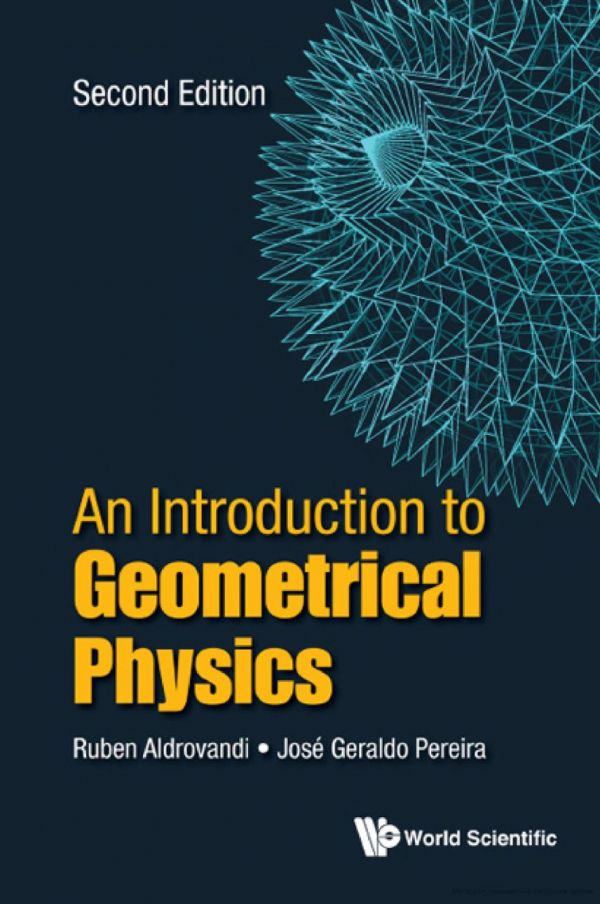
Product details:
ISBN-10 : 9813146839
ISBN-13 : 9789813146839
Author: Ruben Aldrovandi
This book focuses on the unifying power of the geometrical language in bringing together concepts from many different areas of physics, ranging from classical physics to the theories describing the four fundamental interactions of Nature — gravitational, electromagnetic, strong nuclear, and weak nuclear.The book provides in a single volume a thorough introduction to topology and differential geometry, as well as many applications to both mathematical and physical problems. It is aimed as an elementary text and is intended for first year graduate students.In addition to the traditional contents of books on special and general relativities, this book discusses also some recent advances such as de Sitter invariant special relativity, teleparallel gravity and their implications in cosmology for those wishing to reach a higher level of understanding.
An Introduction to Geometrical Physics 2nd Table of contents:
Part 1: MANIFOLDS
1. General Topology
1.1 Introductory remarks
1.2 Topological spaces
1.3 Kinds of texture
1.4 Functions
1.5 Quotients and groups
2. Homology
2.1 Introductory remarks
2.2 Graphs
2.2.1 Graphs, first way
2.2.2 Graphs, second way
2.3 The first topological invariants
2.3.1 Simplexes, complexes and all that
2.3.2 Topological numbers
2.3.3 Final remarks
3. Homotopy
3.1 General homotopy
3.2 Path homotopy
3.2.1 Homotopy of curves
3.2.2 The fundamental group
3.2.3 Some examples
3.3 Covering spaces
3.3.1 Multiply-connected spaces
3.3.2 Riemann surfaces
3.4 Higher homotopy
4. Manifolds and Charts
4.1 Manifolds
4.1.1 Topological manifolds
4.1.2 Dimensions, integer and other
4.2 Charts and coordinates
5. Differentiable Manifolds
5.1 Definition and overlook
5.2 Smooth functions
5.3 Differentiable submanifolds
Part 2: DIFFERENTIABLE STRUCTURE
6. Tangent Structure
6.1 Introduction
6.2 Tangent spaces
6.3 Tensors on manifolds
6.4 Fields and transformations
6.5 Frames
6.6 Metric and riemannian manifolds
7. Differential Forms
7.1 Introduction
7.2 Exterior derivative
7.3 Vector-valued forms
7.4 Duality and coderivation
7.5 Integration and homology
7.5.1 Integration
7.5.2 Cohomology of differential forms
7.6 Algebras, endomorphisms and derivatives
8. Symmetries
8.1 Lie groups
8.2 Transformations on manifolds
8.3 Lie algebra of a Lie group
8.4 The adjoint representation
9. Fiber Bundles
9.1 Introduction
9.2 Vector bundles
9.3 The bundle of linear frames
9.3.1 Structure group
9.3.2 Soldering
9.3.3 Orthogonal groups
9.3.4 Reduction
9.3.5 Tetrads
9.4 Linear connections
9.5 Principal bundles
9.6 General connections
9.7 Bundle classification
Part 3: NATURE’S EXTREME GEOMETRIES
10. Quantum Geometry
10.1 Quantum goups: a pedestrian outline
10.2 Noncommutative geometry
11. Cosmology: the Standard Model
11.1 The geometrical perspective
11.2 The physical content
11.3 The cosmos curvature
12. Planck Scale Kinematics
Part 4: MATHEMATICAL TOPICS
13. The Basic Algebraic Structures
13.1 Some general concepts
13.2 Groups and lesser structures
13.3 Rings, ideals and fields
13.4 Modules and vector spaces
13.5 Algebras
13.6 Coalgebras
14. Discrete Groups: Braids and Knots
14.1 Discrete groups
14.1.1 Words and free groups
14.1.2 Presentations
14.1.3 Cyclic groups
14.1.4 The group of permutations
14.2 Braids
14.2.1 Geometrical braids
14.2.2 Braid groups
14.2.3 Braids in everyday life
14.2.4 Braids presented
14.2.5 Braid statistics
14.2.6 Direct product representations
14.2.7 The Yang–Baxter equation
14.3 Knots and links
14.3.1 Knots
14.3.2 Links
14.3.3 Knot groups
14.3.4 Links and braids
14.3.5 Invariant polynomials
15. Sets and Measures
15.1 Measure spaces
15.1.1 The algebra of subsets
15.1.2 Measurable space
15.1.3 Borel algebra
15.1.4 Measure and probability
15.1.5 Partition of identity
15.1.6 Riemannian metric
15.1.7 Measure and integration
15.2 Ergodism
15.2.1 Types of flow
15.2.2 The ergodic problem
16. Topological Linear Spaces
16.1 Inner product space
16.2 Norm
16.3 Normed vector spaces
16.4 Hilbert space
16.5 Banach space
16.6 Topological vector spaces
16.7 Function spaces
17. Banach Algebras
17.1 Quantization
17.2 Banach algebras
17.3 *-algebras and C*-algebras
17.4 From geometry to algebra
17.5 von Neumann algebras
17.6 The Jones polynomials
18. Representations
18.1 Introductory remarks
18.2 Linear representations
18.3 Regular representation
18.4 Fourier expansions
19. Variations and Functionals
19.1 Curves
19.1.1 Variation of a curve
19.1.2 Variation fields
19.1.3 Path functionals
19.1.4 Functional differentials
19.1.5 Second variation
19.2 General functionals
19.2.1 Functionals
19.2.2 Linear functionals
19.2.3 Operators
19.2.4 Derivatives: Fréchet and Gateaux
20. Functional Forms
20.1 Introductory remarks
20.2 Exterior variational calculus
20.2.1 Lagrangian density
20.2.2 Variations and differentials
20.2.3 The action functional
20.2.4 Variational derivative
20.2.5 Euler forms
20.2.6 Higher order forms
20.2.7 Relation to operators
20.2.8 Continuum Einstein convention
20.3 Existence of a lagrangian
20.3.1 Inverse problem of variational calculus
20.3.2 Helmholtz–Vainberg theorem
20.3.3 Equations with no lagrangian
20.4 Building lagrangians
20.4.1 The homotopy formula
20.4.2 Examples
20.4.3 Symmetries of equations
20.4.4 Final remarks
21. Singular Points
21.1 Index of a curve
21.2 Index of a singular point
21.3 Relation to topology
21.4 Basic two-dimensionals singularities
21.5 Critical points
21.6 Morse lemma
21.7 Morse indices and topology
21.8 Catastrophes
22. Euclidean Spaces and Subspaces
22.1 Introductory remarks
22.2 Structure equations
22.2.1 Moving frames
22.2.2 The Cartan lemma
22.2.3 Adapted frames
22.2.4 Second quadratic form
22.2.5 First quadratic form
22.3 Riemannian structure
22.3.1 Curvature
22.3.2 Connection
22.3.3 Gauss, Ricci and Codazzi equations
22.3.4 Riemann tensor
22.4 Geometry of surfaces
22.4.1 Gauss theorem
22.5 Relation to topology
22.5.1 The Gauss–Bonnet theorem
22.5.2 The Chern theorem
23. Non-Euclidean Geometries
23.1 The age-old controversy
23.2 The curvature of a metric space
23.3 The spherical case
23.4 The Boliyai–Lobachevsky case
23.5 On the geodesic curves
23.6 The Poincaré space
24. Geodesics
24.1 Introductory remarks
24.2 Self-parallel curves
24.2.1 In General Relativity
24.2.2 In optics
24.3 The absolute derivative
24.3.1 Self-parallelism
24.3.2 Complete spaces
24.3.3 Fermi transport
24.4 Congruences
24.4.1 Jacobi equation
24.4.2 Vorticity, shear and expansion
24.4.3 Landau–Raychaudhury equation
Part 5: PHYSICAL TOPICS
25. Hamiltonian Mechanics
25.1 Introduction
25.2 Symplectic structure
25.3 Time evolution
25.4 Canonical transformations
25.5 Phase spaces as bundles
25.6 The algebraic structure
25.7 Relations between Lie algebras
25.8 Liouville integrability
26. More Mechanics
26.1 Hamilton–Jacobi
26.1.1 Hamiltonian structure
26.1.2 Hamilton–Jacobi equation
26.2 The Lagrange derivative
26.2.1 The Lagrange derivative as a covariant derivative
26.3 The rigid body
26.3.1 Frames
26.3.2 The configuration space
26.3.3 The phase space
26.3.4 Dynamics
26.3.5 The “space” and the “body” derivatives
26.3.6 The reduced phase space
26.3.7 Moving frames
26.3.8 The rotation group
26.3.9 Left- and right-invariant fields
26.3.10 The Poinsot construction
27. Symmetries on Phase Space
27.1 Symmetries and anomalies
27.2 The Souriau momentum
27.3 The Kirillov form
27.4 Integrability revisited
27.5 Classical Yang–Baxter equation
28. Statistics and Elasticity
28.1 Statistical mechanics
28.1.1 Introduction
28.1.2 General overview
28.2 Lattice models
28.2.1 The Ising model
28.2.2 Spontaneous breakdown of symmetry
28.2.3 The Potts model
28.2.4 Cayley trees and Bethe lattices
28.2.5 The four-color problem
28.3 Elasticity
28.3.1 Regularity and defects
28.3.2 Classical elasticity
28.3.3 Nematic systems
28.3.4 The Franck index
29. Propagation of Discontinuities
29.1 Characteristics
29.2 Partial differential equations
29.3 Maxwell’s equations in a medium
29.4 The eikonal equation
30. Geometrical Optics
30.1 Introduction
30.2 The light-ray equation
30.3 Hamilton’s point of view
30.4 Relation to geodesics
30.5 The Fermat principle
30.6 Maxwell’s fish-eye
30.7 Fresnel’s ellipsoid
31. Classical Relativistic Fields
31.1 The fundamental fields
31.2 Spacetime transformations
31.2.1 The Poincaré group
31.2.2 The basic cases
31.3 Internal transformations
31.4 Lagrangian formalism
31.4.1 The Euler–Lagrange equation
31.4.2 First Noether’s theorem
31.4.3 Minimal coupling prescription
31.4.4 Local phase transformations
31.4.5 Second Noether’s theorem
32. Gauge Fields: Fundamentals
32.1 Introductory remarks
32.2 The gauge tenets
32.2.1 Electromagnetism
32.2.2 Non-abelian theories
32.2.3 The gauge prescription
32.2.4 Hamiltonian approach
32.2.5 Exterior differential formulation
32.3 Functional differential approach
32.3.1 Functional forms
32.3.2 The space of gauge potentials
32.3.3 Gauge conditions
32.3.4 Gauge anomalies
32.3.5 BRST symmetry
32.4 Chiral fields
33. More Gauge Fields: Wu–Yang Copies
33.1 The ambiguity
33.2 The connection space M
33.3 Copies in terms of covariant derivative
33.4 The affine character of M
33.5 The copy-structure of space M
34. General Relativity
34.1 Introductory remarks
34.2 The equivalence principle
34.3 Pseudo-riemannian metric and tetrad
34.4 Lorentz connections
34.5 Curvature and torsion
34.6 General Relativity connection
34.7 Geodesics
34.8 Bianchi identities
34.9 Einstein’s field equations
34.10 Spin and (the break of) universality
35. Teleparallel Gravity
35.1 Introductory remarks
35.2 Fundamentals of Teleparallel Gravity
35.2.1 Geometrical setting
35.2.2 Frames and inertial effects
35.2.3 Translational gauge potential
35.2.4 Teleparallel spin connection
35.2.5 Teleparallel lagrangian
35.2.6 Field quations
35.3 Some achievements of Teleparallel Gravity
35.3.1 Separating inertia and gravitation
35.3.2 Geometry versus force
35.3.3 Gravitational energy-momentum density
35.3.4 A genuine gravitational variable
35.3.5 Gravitation without the equivalence principle
35.4 Final remarks
36. Einstein–Cartan Theory
36.1 Introduction
36.2 Field equations
36.3 Gravitational coupling prescription
36.4 Particle equations of motion
36.5 Conceptual issues
37. de Sitter Invariant Special Relativity
37.1 Towards a de Sitter special relativity
37.1.1 de Sitter as a Quotient Space
37.1.2 Rationale for a de Sitter special relativity
37.2 de Sitter spacetime and stereographic coordinates
37.2.1 Large pseudo-radius parameterization
37.2.2 Small pseudo-radius parameterization
37.3 Some properties of the cone spacetime M
37.3.1 Geometric relation between M and M
37.3.2 The nature of the cone singularity
37.3.3 Transitivity and the notions of distance and time
37.4 de Sitter transformations and Killing vectors
37.5 Transitivity and the notion of motion
37.6 Dispersion relation of de Sitter relativity
37.6.1 Ordinary special relativity revisited
37.6.2 de Sitter special relativity
37.7 Gravitation in Cartan geometry
37.7.1 General Relativity in locally-de Sitter spacetimes
37.7.2 Some cosmological consequences
People also search for An Introduction to Geometrical Physics 2nd:
an introduction to geometry
an introduction to physics
introduction to geometric optics
an introduction to geometric topology
an introduction to general relativity spacetime and geometry pdf
Tags: An Introduction, Geometrical Physics, Ruben Aldrovandi
You may also like…
Physics - Solid State Physics
Solid State Physics An Introduction to Theory 1st Edition Joginder Singh Galsin
Computers - Computer Business & Culture
Tomorrow’s lawyers : an introduction to your future Second Edition Susskind
Mathematics - Number Theory
An Introduction to Number Theory with Cryptography, Second Edition Kraft
Science (General)
An introduction to financial mathematics : option valuation Second Edition. Edition Hastings
Physics - Solid State Physics
Physics - Quantum Physics


